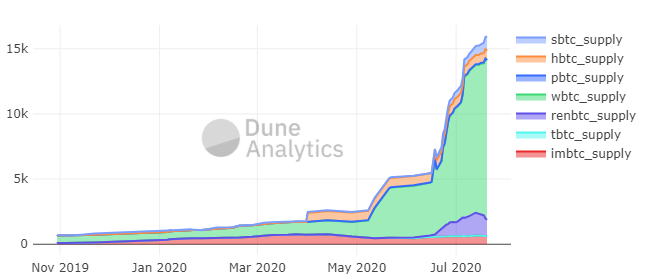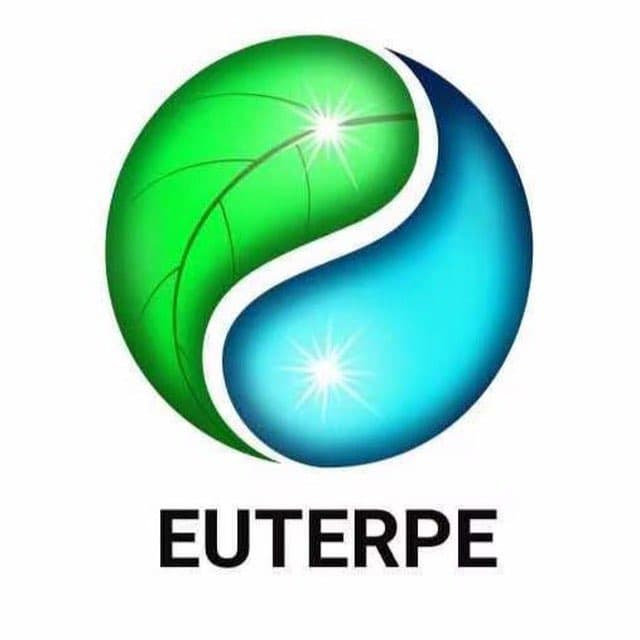Over the past month, the amount of Bitcoin, value tied and wrapped under the pretense of an ERC-20 token, has soared over 240% since June 15th to now. On the day of June 15th, the amount of Bitcoin value on the Ethereum blockchain was valued around 5,448 full Bitcoins. That amount has more than 3 folded to 18,579 Bitcoins at the time of this writing pushing the percentage of Bitcoin value on Ethereum close to 1% of the ETH market cap. To give you perspective on how much that is, that would be equivalent to about $176 million surpassing the value of “digitized gold” tokens on the Ethereum blockchain of XAUT & PAXG combined.
Having Bitcoin collateralized on Ethereum was made popular by Wrapped Bitcoin (WBTC) which is considered the first ERC-20 token backed 1:1 with Bitcoin. Up until now we can see that there are at least 7 different Bitcoin backed ERC-20 tokens on the Ethereum blockchain with WBTC being the most dominant.

(Figure 1) Amount of Bitcoin backed ERC-20 tokens on Ethereum. Source: DuneAnalytics @eliasimos
Wrapped BTC is clearly on top with a total supply 9 times more than the 2nd ranked Synthetix's synthetic Bitcoin (sBTC).

(Figure 2) Breakdown of the Bitcoin backed ERC-20 tokens by amount. Source: DuneAnalytics @eliasimos
Currently, XAUT has a market cap of around $88 million while PAXG has a market cap around $46 million. And in fact, the value of WBTC alone has surpassed the amount of XAUT during the past month.
A main reason for the surge in Wrapped Bitcoin on Ethereum is the recent explosive growth of the DeFi movement the past month with the likes of trendy yield farming making way for a new wave of crypto finance. DeFi exchange, Curve, has also been a harbinger by expanding into BTC liquidity pools on their platform boasting minimal slippages.
The hotly contested debate (or similarities) between digital gold and real life gold is an ongoing pervasive subject. Bitcoin's original intention of becoming the next form of global currency has shifted its narrative to inadvertently being an alternative store of value, going up against the traditional form of a store of value asset, gold. But likewise with anything in this space is that things change in an apace manner. Over the past year gold-backed stablecoins have jumped on the crypto scene allowing investors to invest in the physical commodity albeit via an ERC-20 token on Ethereum. But its uses cases are still to be seen as the only true usage is that of its traditional counterpart.
Just recently our PANews put out an article
postulating if XAUT will become the next USDT as it rapidly grows amid the Global Economic Crisis.
If these digitized gold tokens have merely the same usage as digital gold, Bitcoin, then what are the innocuous nuances that can be taken away? Which one epitomizes a true global hedge for when equity markets crumble?
But as a matter of fact, the past year of global markets turmoil struck by the pandemic has seen increased levels of correlation between Bitcoin and gold leading to the question of which one to invest in then? The relationship between Bitcoin and gold has even been leveraged by the popular Stock-to-Flow model which predicates Bitcoin's potential price growth to that of the scarcity relationship between current and future supplies of real world commodities (although this relationship has been debunked).
For the time being, it seems as if Bitcoin will continue to be king in the crypto-sphere. Despite the influx of gold backed stablecoins, who's to say that both cannot co-exist. At a recent fireside chat during the Asia Blockchain Summit 2020 , Samson Mow humorously tells Panony's Alyssa Tsai:
"It's a way for people to prove out their beliefs in the marketplace. Peter Schiff can come to BTSE short Bitcoin and long gold if he wants to."









